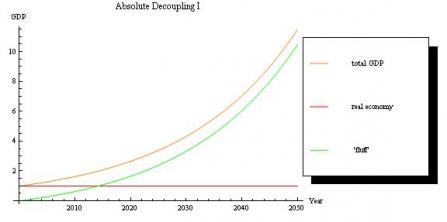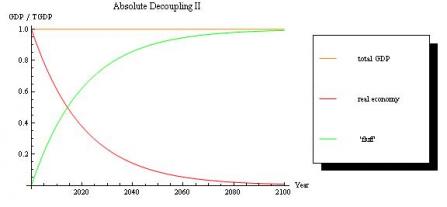Economic Theology: Angels Dancing On The Head of A Pin
By David A. Jones
19 March, 2012
Daly News
There’s an old question in theology: “How many angels can dance on the head of a pin?” The supposed answer is “as many as you like.” A pin is a physical object, whereas angels are non-corporeal beings.

Elizabeth Chandler's drawing of angels dancing on a pin
I consider mainstream (neoclassical) economics a kind of modern day theology, and the question about angels is akin to the question, “How much economic growth (GDP growth) can our ecosystems cope with?” For the economic “theologians” the answer is once again “as much as you like,” because economic growth can supposedly be decoupled from physical impacts.
First a reminder about what GDP is. GDP stands for gross domestic product. It’s a measure of the total market value of the goods and services produced within a nation’s borders during a year. The basic formula for calculating GDP is:
GDP = private consumption + gross investment + government spending + (exports − imports)
One way to calculate GDP in practice is to track the monetary exchanges that occur when final goods and services are purchased. GDP, therefore, measures how frantically money is flowing among people, companies, banks, and other players in the economy. And so the dancing angels become monetary exchanges, the pin becomes the Earth, and the “theological question” becomes, “How many monetary exchanges can fit on the Earth?”
Mainstream economists argue that a constant rate of GDP growth is desirable. In other words, monetary exchanges are supposed to grow exponentially and forever on a finite planet. This is only possible if an increasingly small component of GDP growth relates to physical impacts (i.e., a smaller and smaller number of activities that add to GDP produce any environmental impact). Otherwise the physical impact of our economies will grow exponentially too — a truly impossible scenario. You cannot have an infinite number of people dancing on the head of a pin! Unlike angels, people are corporeal beings.
The above scenario — an ever smaller fraction of GDP representing physical impacts — is referred to by economists as decoupling. It is the only way to justify a system predicated on the assumption of continuous GDP growth on a finite planet.
Let’s do the math and see if a strategy of continuous growth with decoupling is reasonable. Say we want to decouple GDP growth from physical impact, which is to be fixed at “one planet’s worth.” The economy then consists of two sectors: a “real economy” with a physical impact = 1 in units of GDP and a service sector with no physical impact, denoted as “fluff.” If we start off the economy in the year 2000 as 100% “real” and 0% “fluff” then absolute decoupling corresponds to the plot below:

If total GDP is growing, then in order for physical impact to remain constant, the “real economy” must shrink year after year as a fraction of total economic activity. Dividing all the curves in the above plot by total GDP, we get the plot below, showing what fraction of the economy will be “real” verses “fluff” over the next 100 years:

After about 50 years the “real” sector of the economy has fallen to around 10% of total economic activity. In another 50 years it falls to less than 1% . The above plots illustrates the scenario known as absolute decoupling — the case where the economy can be made as large as we like, because the fraction of that economy having a physical impact can get as small as we like.
But is this realistic? We are assuming a two-sector economy — “real” and “fluff.” “Real” would include activities such as farming and fishing, which require productive land, water, and other resources. “Fluff” would consist of services such as massages and economics lessons. Absolute decoupling assumes that, at some point in the not-too-distant future, we can reach a point where 99% of the money circulating in the economy will be spent on “fluff” – economics lessons and massages – while 1% of it will be spent on “real” — farming and fishing.
As exponential growth continues, you would be able to buy all the productive land and natural resources of the planet for the price of a massage! This is clearly absurd — the productive parts of the economy are the physical basis for all the “fluff” that rests atop it. The “real” will never be valued as low as just 1% or less of total GDP. Moreover there is no legitimate planning effort even to make this absurdity happen. Things are very much left to their own devices. The idea of “absolute decoupling” is more a kind of special pleading to justify the economic status quo, rather than something we are acting decisively to achieve.
There are other reasons to object to a strategy of absolute decoupling, like the fact that “fluff” can’t achieve absolutely zero physical impact — people are not angels after all. And there is the very reasonable objection that the economy should not become the treadmill of faster and faster exchanges of “fluff,” even if economists demand such exchanges to keep GDP growth going! Absolute decoupling is an absolute pipedream — at some point the economy will have to stop growing.
If we’re able to achieve some degree of decoupling, it will buy us some time to avoid ecological collapse. Can we use this time to realize that perpetual GDP growth on our finite planet is a recipe for mass-suicide and begin sensibly reducing the scale of the global economy? We will need to do three things. First and foremost, we’ll need to put aside the absurd belief that another unit of GDP growth is like another non-corporeal angel on the head of a pin. Next, we can ask the question “How might a steady state economy work, and how can we get there?” Lastly, we’ll need a reformed economics profession — one which agrees this question is sensible and gives us some sensible answers to it.
David A. Jones is a PhD student in theoretical physics at Southampton University in the UK. He writes frequently for the Positive Money blog.
Due to a recent spate of abusive, racist and xenophobic comments we are forced to revise our comment policy and has put all comments on moderation que.


